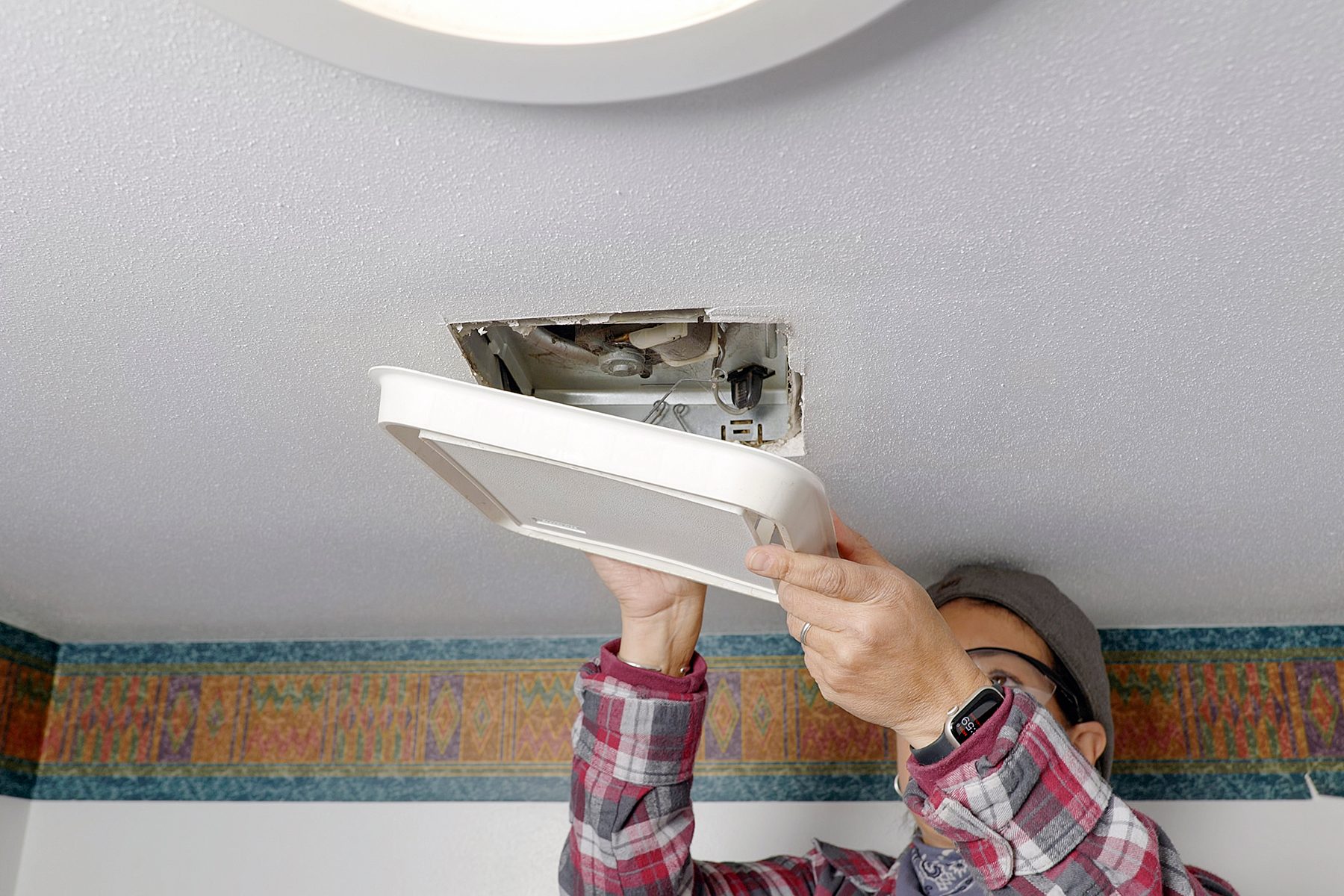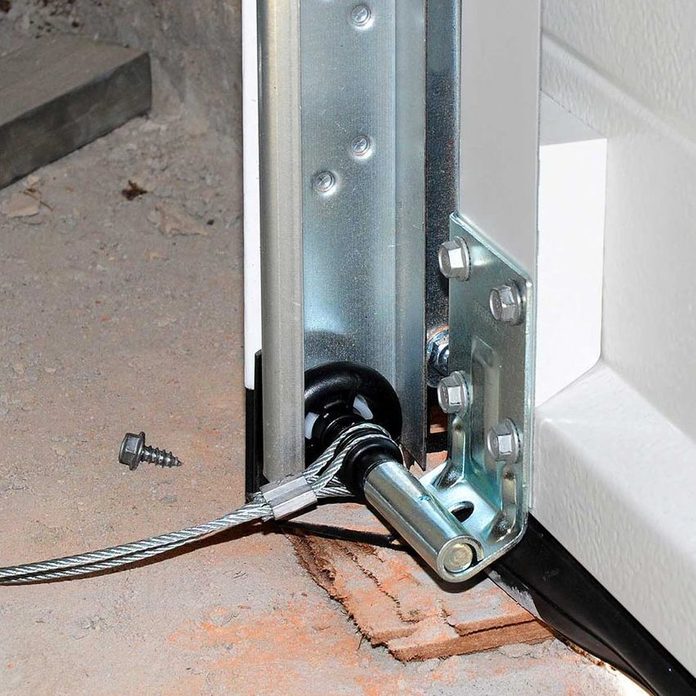1
/
15
Cleaning Inside the Dryer and Dryer Vent
Built-up lint inside dryer cabinets causes more than 15,000 fires every year. Lint escapes through tiny gaps around the edges of the dryer drum and falls into the cabinet, especially when the exhaust vent or vent cap is clogged and airflow is restricted. The lint can get ignited by electric heating elements, gas burners or even a spark from the motor, and the flames then travel through the lint-lined exhaust vent.
A plugged dryer vent will cause your dryer to run inefficiently; it can even cause a house fire. Dryers that are centrally located in houses are most prone to plugging because they have longer ducts. Excess lint is only one reason ducts get clogged; nesting pests and stuck exhaust hood flappers can also cause backups. Stronger odors and longer dry times are two signs your vent is plugged.
2
/
15
Quality Stock Arts/Shutterstock
Cleaning the Bath Fan
“Bathroom exhaust fans are one of your best defenses against mold in the bathroom,” Michael Sacenti of American Healthy Homes says. Dust and lint can build up in your bathroom fan making it harder for the fan to do its job. And because they’re most often located on the ceiling and out of the way, you may not even notice it’s dirty.
Luckily, bathroom fans are easy to clean. Grab the edge of the cover and pull down. Squeeze the springs to release them from the slots and remove the cover.
3
/
15
Cleaning Faucet Aerators
Aerators are found on almost every kitchen and bath faucet, and if water flow slows or becomes uneven, clogs inside the aerator are usually the cause. Fortunately, cleaning and repairing a clogged faucet is an easy problem to fix.
4
/
15
Checking for High Water Pressure
A technician was assisting a water softener installer who was replacing a fairly new softener because the first one had ruptured and filled the pipes with little zeolite beads.
The installer didn’t seem too worried about why the first one failed, but the assistant did a little investigating. A water pressure test gave a reading of more than 110 lbs. psi. The culprit was the 20-year-old pressure-reducing valve. After a new valve was installed, the pressure went down to about 75 lbs. Pressure-reducing valves are usually found near the main water shutoff valve, but not all homes have them. It depends on your municipality.
High water pressure can harm pipes, connections, and appliances. It also creates water hammer and wastes massive amounts of water. Checking for high water pressure is an often-overlooked maintenance item, and one that’s easy enough to perform. A new pressure-reducing valve and a simple pressure gauge like this one that hooks up to a spigot or laundry tub faucet are both available at home centers.
5
/
15
Monitoring Your Water Heater
With a few minutes of basic maintenance once a year, you can extend the life of your water heater tank and maintain its efficiency and safety.
6
/
15
Replacing Furnace Filters
You should replace your air filters at least four times a year, but it’s best to check them once a month. This keeps air in the house healthy and your system running efficiently because they are not clogged with debris or dust. “Furnaces need fresh air to work properly, and if your filters are dirty and clogged, the system can’t breathe,” Alexander Siv of Amherst Plumbing and Heating says. “This can lead it to overheat and fail early.”
7
/
15
Checking the HVAC Condensate Line
When you see water puddling around the furnace with the A/C running, you have a problem with the condensate drain tube. Condensation from air conditioning coils contains bacteria that can form slime and clog the condensate pan drain tube. The tube can also be accidentally knocked loose or the pump unplugged. “Check your condensate pump and tube a few times a year,” Siv says. “Unclog it if sludge has built up and check to make sure it is draining right.” You can prevent slime and eliminate drain tube clogs in two easy steps.
8
/
15
Blowing Out Soffit Vents
Blow out debris from your soffit vents to maintain good attic ventilation. It’ll save on air conditioning costs in summer and protect your roof from condensation in winter.
9
/
15
Cleaning Weep Holes
Weep holes may be the tiniest feature of many sliding windows and vinyl replacement windows, but they serve a big function. The little holes, located on the exterior bottom of the frame, are an outlet for rainwater to drain away from the home, but they can often become clogged up with debris.
To make sure your weep holes are working properly, spray the outside of the window with a garden hose – a steady stream of clean water should exit from the holes. If it doesn’t, use a wire hanger or compressed air to force the blockage out. Re-test with fresh water to ensure they’re completely cleaned.
10
/
15
Cleaning Outdoor Lights
Like anything that lives outdoors, your outdoor light fixtures get dirty. Get in the habit of cleaning and inspecting your outdoor lights once a year, especially checking for any pest nests. The heat provided by outdoor lights makes an ideal environment for mice and other rodents.
11
/
15
Sealing Outlets and Ceiling Boxes
The tiny gaps around outlets on exterior walls and ceiling boxes let cold air in (and warm air out). Sealing these areas takes just half a day and will help cut down on drafts (and your heating bill!).
12
/
15
Inspecting the Automatic Garage Door Safety Shutoff
Test that the safety features of your automatic-opening garage door are still in good shape. That includes the safety beams, which should stop the door from closing if it detects anything in the door’s path.
13
/
15
Lubricating Garage Doors
Most garage doors consist of a series of panels hinged together with rollers on the side. It’s important to keep the hinges and rollers lubricated. Not only will that cut down on annoying noises, it’ll prolong the life of your garage door and keep it operating smoothly. Be sure to use a lithium-based grease or silicone grease lubricant. You can also find lubricants specifically made for garage doors at most home centers.
14
/
15
Looking at Garage Door Springs
Coat the overhead torsion springs mounted above roller tracks with a garage door lubricant. All springs will eventually break because of metal fatigue and/or corrosion, but lubing them at least once a year will make them last longer. Spraying can be messy; it’s smart to protect the wall behind the spring with a piece of cardboard. Lube the rollers while you’re at it.
15
/
15
Checking Garage Door Balance
A properly balanced door is less likely to injure someone or something and keeps the door opener from working too hard, which will shorten its life.
To check the balance on a door, close the door and then disengage the opener by pulling the opener release handle. Manually pull up the door about halfway and let go. A properly balanced door will stay in the halfway position by itself. If it falls, the tension needs to be increased. If the door rises, the door spring has too much tension, which means it’s working harder than it needs to.
Check the door a couple times a year. Adjusting the spring tension is tricky and dangerous. Call a garage door professional to perform the service, or see advanced garage door repairs.
FAQ
Which overlooked tasks hurt home value the most?
Any overlooked tasks that manage moisture levels in and around a home are the most costly. This includes making sure dehumidifiers and sump pumps work in the basement, plumbing fixtures are leak-free and shut-off valves operate, gutters are cleaned and downspouts are in place, siding and roofing materials are sound and attic ventilation is adequate. Moisture issues can cause rotting wood, mold and mildew or foundation problems.
About the Experts
- Michael Sacenti owns American Healthy Homes. He has 10 years of experience in the mold remediation industry and 40 years experience in real estate maintenance.
- Alexander Siv owns Amherst Heating and Plumbing in Amherst, Massachusetts. He has a master plumber’s license in Massachusetts and more than 10 years of plumbing experience.



































